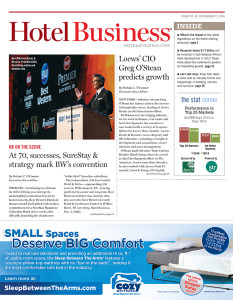Editor’s note: Welcome to our second installment of Truth Trackers, where Hotel Business, in partnership with CHMWarnick, sets out to debunk common myths within our industry. Our chief investigators, Richard Warnick, managing director/co-chairman; Chad Crandell, managing director/CEO; and Ken Wilson, managing director/co-chairman, are on the case to field each myth and shed some light on what is false and what is fact. We have quite a few myths to bust, but would also like to hear from you. If you have a “truth” that you want us to track, our three investigators and their team of hotel experts are on it. You can email me at [email protected]
Myth: Hotel owners know the cost associated with branding and operating their hotels.
Truth: Now we’re getting to the good stuff. It’s common industry knowledge that base management fees for a branded hotel typically run between 4% and 6% of a hotel’s gross revenue. This fee range will vary depending upon hotel size, revenue stream and management structure—whether managed by the brand, a third party with a brand franchise or perhaps a variation thereof like the “manchise,” one of the more creative phrases to work its way into industry vernacular this year (along with “Marwood,” “dimming” and the “sharing economy”…but we digress). So, the short answer is yes, of course hotel owners know the cost of branding and management. But, to track the truth of this statement, a better question might be: Do hotel owners know the total amount that can be attributed to brand and management costs? We suspect many may be surprised to learn that actual “all-in” costs charged for related services are typically 2-2 1/2 times the base 4-6% brand/management fee.
The good news is that brands are required to disclose all related fees for services provided. The bad news is: (a) charges for services are spread across many portions of the P&L statement, with some even booked direct through intercompany accounts with no supporting backup, making it nearly impossible to track and quantify; and (b), in order to get your head around brand fees in totality, you must comb through voluminous disclosure statements (the last one we reviewed was 51 pages long).
Some related fees are more obvious and easily tracked, such as central marketing, reservations, regional/national sales and loyalty programs. Others are less so, including mandatory tuition reimbursement programs (up to $10,000 per employee!) and property vulnerability and penetration scanning fees (this one even stumped us!). There are many additional costs—some mandatory; others optional—related to branding and management. With budget season underway, now is a good time to get acquainted with these fees and programs, some of which owners may elect to opt out of—but if not, will be included by default. Consider that some programs may not make sense for all property types or markets, and owners should avoid paying for something that isn’t needed. It’s important to be aware of all brand programs and related fees, and to have a process for monitoring and evaluating effectiveness. Revenues are projected to grow in 2017, but expenses are on pace to catch up—maybe even exceed revenue growth in percentage terms—in the not-too-distant future. Understanding the true cost of brands and operators is eye-opening, and can assist in holding those accountable for delivering a return as comprehensive as the fees owners are paying.
Until next time, Truth Trackers signing off.

